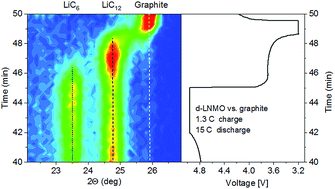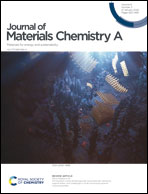Stroboscopic neutron diffraction applied to fast time-resolved operando studies on Li-ion batteries (d-LiNi0.5Mn1.5O4vs. graphite)†
Abstract
The high penetration ability of neutrons and dramatic character of crystal structure modifications occurring in battery materials during electrochemical cycling make neutron powder diffraction an obvious method to study the reaction mechanisms in rechargeable cells. Unfortunately, a typical balance of the available intensities of neutron beams and the amounts of active materials in commercial battery systems often limits the area of study to slow cycling rates or forces the use of too large amounts of materials, which in turn is incompatible with reliable electrochemistry. Herein we present a practical implementation of stroboscopic operando neutron diffraction to allow studying the structural changes occurring in a battery composed of a next generation 5 V disordered LiNi0.5Mn1.5O4 spinel cathode versus graphite during repetitive cycles at incredibly fast rates (up to 15C). We demonstrate that the graphite lithiation mechanisms at fast rates are different from those observed at reasonable rates. In particular, the earlier appearance and disappearance of lithiated graphite stages 1 and 2 in the charge and discharge processes, and also the suppression of the formation of the LiC18 phase can be associated with cell degradation at fast charge rates. This result is in agreement with the theoretical ‘shrinking-annuli’ model developed to simulate the electrochemical processes occurring during graphite lithiation at fast rates.



 Please wait while we load your content...
Please wait while we load your content...